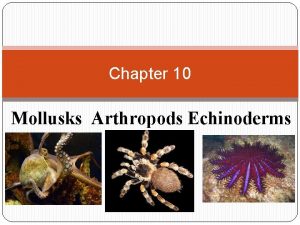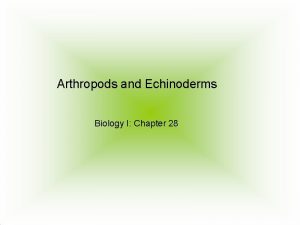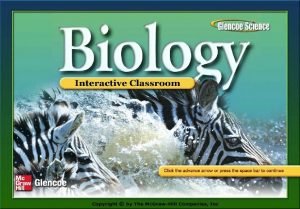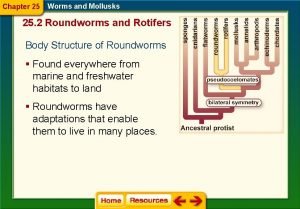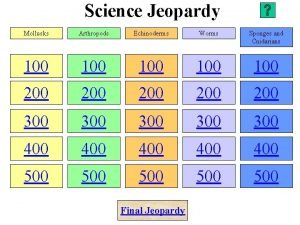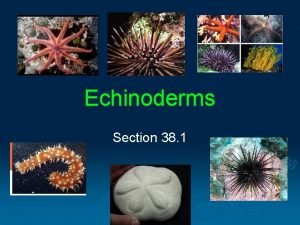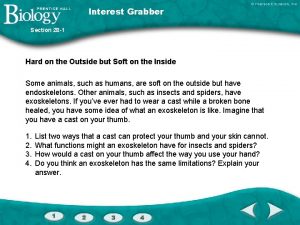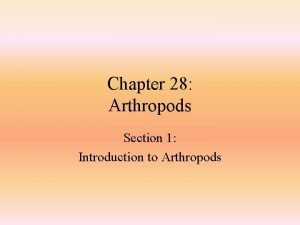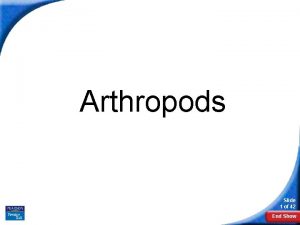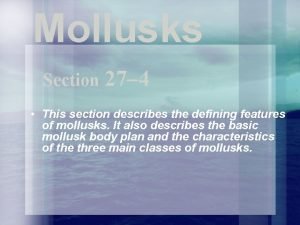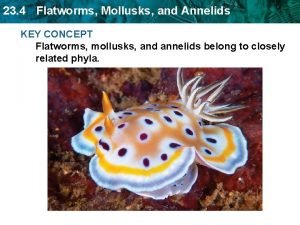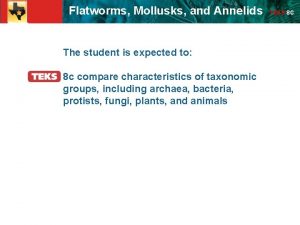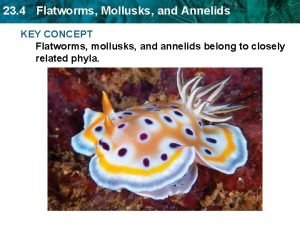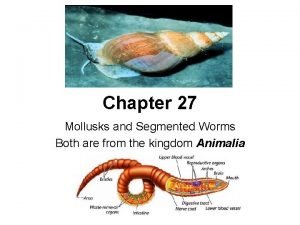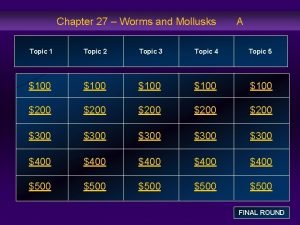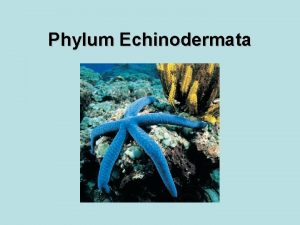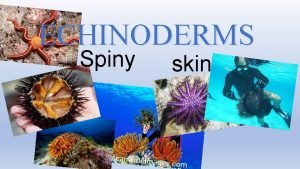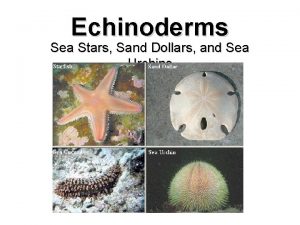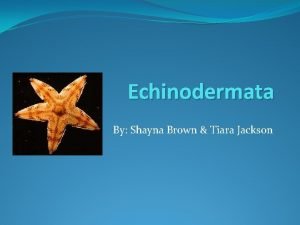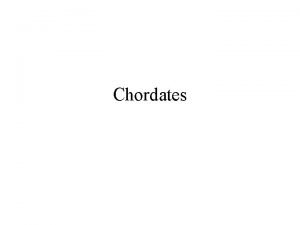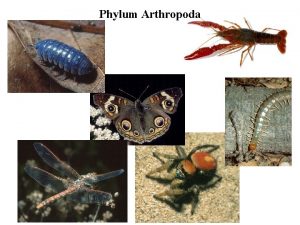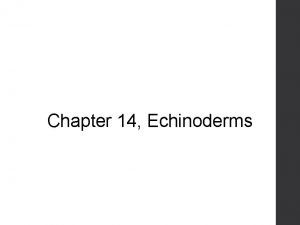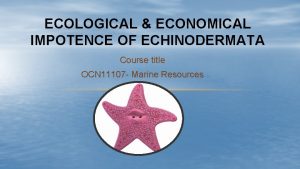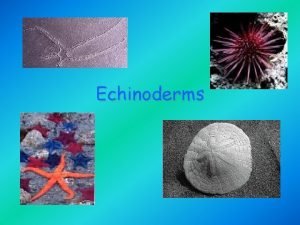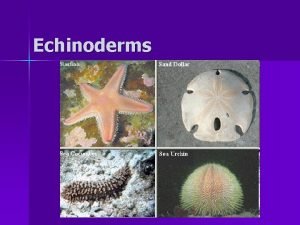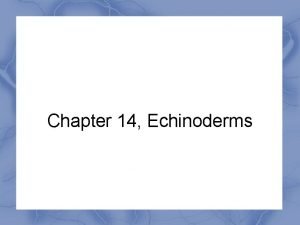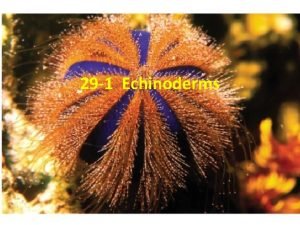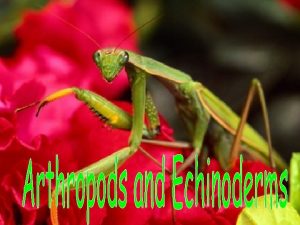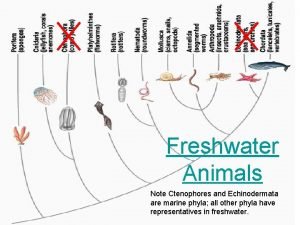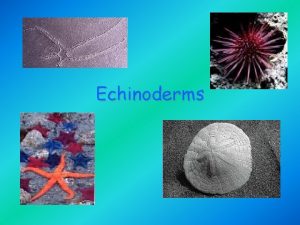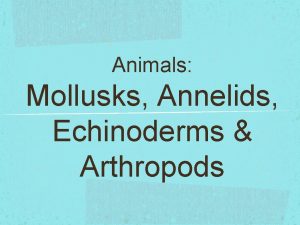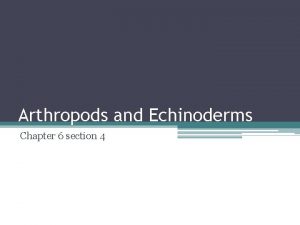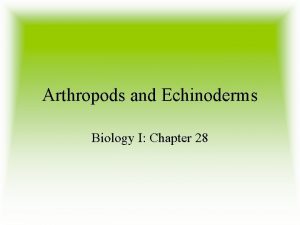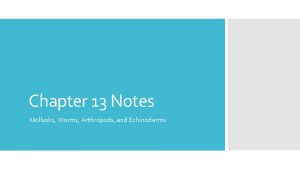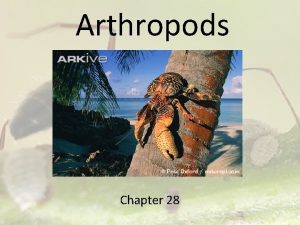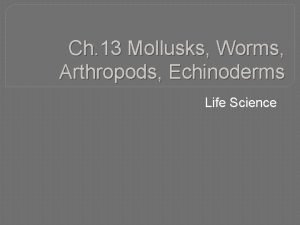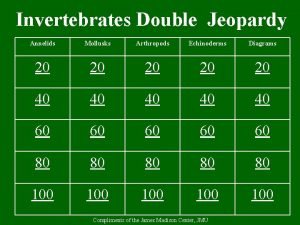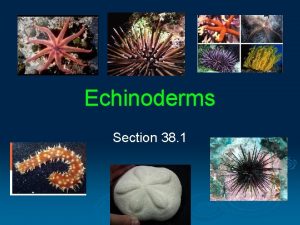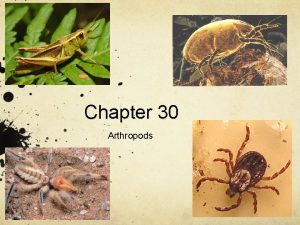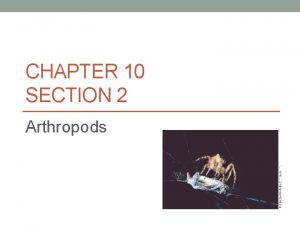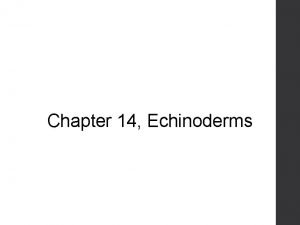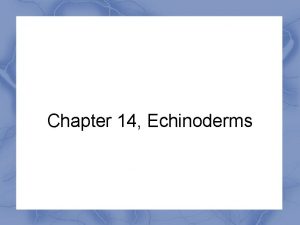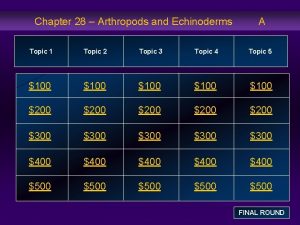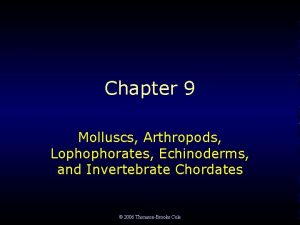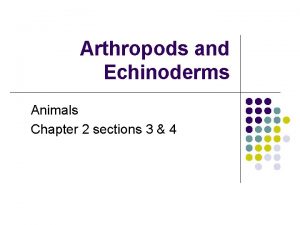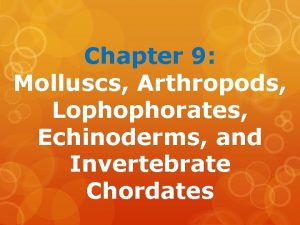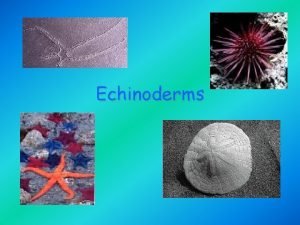Chapter 10 Mollusks Arthropods Echinoderms Section 1 Mollusks































- Slides: 31

Chapter 10 Mollusks Arthropods Echinoderms

Section 1: Mollusks Invertebrates with soft, un-segmented bodies Covered with a shell Contains a MANTLE Thin layer of tissue that covers its organs Contains a FOOT that has different functions: Crawling Digging Catching prey Bilaterally symmetrical with a two- opening digestive system Most have open Circulatory System

Obtaining Oxygen Aquatic mollusks have GILLS Organs that remove oxygen from the water Contain cilia to help water flow Rich supply of blood vessels for gas exchange

Classification of Mollusks 3 groups classified by: Presence of a shell Type of foot Type of nervous system 3 groups Gastropods Bivalves Cephalopods

Gastropods Largest of three groups Snails and slugs Can live anywhere Single external shell or no shell at all Obtaining food (different ways) Herbivores- eat plants Scavengers- eat decaying material Carnivores- eat other animals All use RADULA Flexible ribbon of tiny teeth for eating Move by creeping on broad foot

Bivalves With 2 shells held together by hinges and strong muscles Oysters, clams, scallops, mussels Found in watery environments Obtaining food: Omnivores- eat plants and animals Filter feeders that strain organisms from water Food sticks to mucus that covers gills Cilia sweeps food into mouth

Movement and Protection Movement Larvae float or swim in water Oysters and mussels attach to rocks Clams move VERY slowly or dig into mud Protection If sand, or other irritant, lodges between mantle and shell, then the mantle produces a smooth pearly coat to cover the irritating object. Sometimes a PEARL will form

Cephalopods Ocean-dwelling carnivores Foot is adapted to form tentacles around its mouth Some have no shell (octopus) Some have internal shell (squid and cuttlefish) Some have external shell (nautilus) Only mollusks with a closed circulatory system Large eyes and excellent vision Large brains and ability to remember Captive ones know when it is feeding time

Obtaining Food and Movement Tentacles contain sensitive suckers that receive sensations of touch and taste Organism does not need to touch in order to taste Suckers respond to chemicals in water Catches prey using muscular tentacles Crushes prey in its beak and cuts flesh with radula MOVEMENT- swim by propulsion Squeeze water out of mantle cavity through tube Move in opposite direction like a rocket

Section 2: Arthropods Crabs, lobsters, centipedes, spiders, grasshoppers, scorpions Invertebrates with external skeletons and segmented bodies Have jointed attachments called APPENDAGES Wings, mouthparts, and legs Athros (“joint”) + Podos (“foot” or “leg”) Bilateral symmetry Open circulatory system Digestive system with 2 openings Reproduce sexually

Body Structure Exoskeleton Waterproof cover that acts as outer skeleton Protection and prevents evaporation of water Structure suggests that arthropods may be 1 st animal on land Shed outgrown exoskeleton by MOLTING Segmented body Jointed appendages Flexibility and movement Highly specialized tools for specific functions Example: Antenna- contains sense organs

Classification of Arthropods Crustaceans (crawfish, lobster, shrimp, crabs) Arachnids (spiders, mites, ticks, scorpions) Centipedes Millipedes Insects (moths, caterpillars, cockroaches, bees)

CRUSTACEANS Crab, shrimp, lobster, crayfish Arthropod with: 2 -3 body sections 5 or more pairs of legs 2 pairs of antennae Have gills to obtain oxygen Gills are located under the shell Can be predators, scavengers, or herbivores

Life Cycle of Crustaceans MICROSCOPIC, SWIMMING LARVAE (bodies do not resemble adult) SOME LAY EGGS AND OTHERS RELEASE LARVAE DEVELOP INTO ADULTS BY METAMORPHO SIS

ARACHNI DS Spiders, mites, ticks, scorpions Arthropods with: 2 body sections 4 pairs of legs No antennae 2 body sections Head and midsection Hind end called the ABDOMEN Contains reproductive organs and part of the digestive system

Spiders Predators that eat insects Some hunt down prey Others spin webs to trap prey Have hollow fangs used to inject venom into prey Venom turns prey’s tissues into mush Use fangs as a drinking straw to eat Most spiders do not bite humans and those that do are mostly not poisonous except the brown recluse and black widow

Mites, Scorpions, Ticks MITES SCORPIONS TICKS • Live in hot climates • Parasites that live mites, on outside of host’s Chiggers • Usually active @ body • Parasites nighttime • Nearly every land • Ear mites give dogs • Spine-like stinger at animal has a tick and cats itchy ears the end of the species that sucks abdomen its • Dust allergies may blood actually be allergies • Uses stinger to to inject venom into • Deer tick spreads the exoskeletons of prey, usually a spider Lyme Disease in dust mites or insect humans • Examples: Ear

Centipedes and Millipedes Arthropods with: 2 body sections One with a head with 1 pair of antennae Long abdomen with many segments Centipedes have 1 pair of legs for each segment 80+ segments Predators that inject venom in prey Millipedes have 2 pairs of legs for each segment Scavengers that eat dying leaves Curl into a ball when danger arises

Section 3: INSECTS Moths, caterpillars, dragonflies, cockroaches, bees Arthropods with: 3 body sections (Head, Thorax, Abdomen) 6 legs 1 pair of antennae Usually 1 -2 pairs of wings Head- contain sense organs like antennae and eyes Thorax- midsection where legs/wings attach Abdomen- contain internal organs

Obtaining food Mouthparts are adapted for a highly specific way of getting food Lapping mouthparts of a fly Sucking mouthparts of a butterfly or cicada Chewing mouthparts of an ant

Life cycle Begin as tiny, hard-shelled fertilized eggs Go through metamorphosis (2 types) Complete Metamorphosis- 4 stages (butterflies, ants) Eggs hatch into larvae Larvae usually look like worms and specialized for eating and growing Larvae becomes Pupa- enclosed in protective covering Major changes in structure occurring in this phase Pupa becomes an Adult


Life Cycle continued… Gradual Metamorphosis- grasshoppers, dragonflies Egg hatches into Nymph No distinct larval stage Looks like adult but without wings Nymph molts (sheds) several times before becoming an adult

Gradual Metamorphosis

Name__________________ Subject_________________ Label the diagram of the cicada using the word bank below. Then view the parts of the insect under the dissecting scope. Use the article on NB pages 13 -14 for questions below. What type of metamorphosis does this insect have? ____________________. What type of mouth parts do they have? ________________________. Head Thorax Compound Eye Abdomen 3 Oceli Wing Antennae Jointed Legs

Label the diagram below and view under the dissecting scope.

Section 4: Insect Ecology- study of food chains and other ways organisms interact with their environment Food chain- series of events in which one organism eat another in order to obtain energy All food chains have producers and consumers (some have decomposers) Insects as: Consumers of plants (caterpillars) Prey to animals (birds eat insects) Decomposers (termites and dung beetles)

Other insect interactions Act as pollinators Moving pollen among plants Spread disease-causing organisms Malaria- spread by mosquitoes Controlling pests by using Chemicals- pesticides Traps Other living things Biological control- using a natural predator to kill harmful insects Example: Lady bugs eat aphids that harm plants

Section 5: Echinoderms Sea stars, sea urchins, sand dollars Invertebrates with internal skeleton Contain water vascular system Fluid-filled tubes Have an Endoskeleton Internal skeleton made of hardened plates Give animal a bumpy texture Radial symmetry in multiples of 5 like spokes on a wheel

Movement and Reproduction Use tube feet for movement Fill with water and act like tiny suction cups Reproduce sexually Females release eggs into the water Males release sperms into the water Eggs are fertilized in the water Fertilized eggs become swimming larvae Larvae metamorphosis into adults

4 major groups Sea Stars Brittle Stars Sea Urchins Sea Cucumbers • Predators that eat mollusks • Capture prey with its tube feet • Forces its stomach out through its mouth • Forces itself inside the animal and eats insides • Arms are long and slender • Tube feet have no suction cups, so only used for capturing food and not for movement • Move by waving arms in a snake-like motion • No arms • Covered with moveable spines for protection • Use band of tube feet that extend out from between spines for movement • Scrape and cut food • Look like cucumbers • Can be red, brown, blue or green • Bodies are soft, flexible, and muscular • Filter feeder that crawls with tube feet • Mouth surrounded by
 Echinoderms
Echinoderms Horseshoe crab respires through lungs.
Horseshoe crab respires through lungs. Vampire squid
Vampire squid Chapter 25 section 4 segmented worms
Chapter 25 section 4 segmented worms Section 38-1 review echinoderms answer key
Section 38-1 review echinoderms answer key Class holothuroidea examples
Class holothuroidea examples Section 28-1 introduction to the arthropods answer key
Section 28-1 introduction to the arthropods answer key 28-1 introduction to arthropods answer key
28-1 introduction to arthropods answer key Section 28-1 introduction to the arthropods
Section 28-1 introduction to the arthropods Tentacled mollusk
Tentacled mollusk Section 4 flatworms mollusks and annelids
Section 4 flatworms mollusks and annelids Section 4 flatworms mollusks and annelids
Section 4 flatworms mollusks and annelids Section 4 flatworms mollusks and annelids
Section 4 flatworms mollusks and annelids Chapter 27 mollusks and segmented worms answer key
Chapter 27 mollusks and segmented worms answer key Chapter 27 worms and mollusks
Chapter 27 worms and mollusks The most active mollusks are the
The most active mollusks are the Holothuroidea
Holothuroidea Endoskeleton, often has spiny skin
Endoskeleton, often has spiny skin Sun____sand___sea
Sun____sand___sea Body cavities
Body cavities Protostome vs deuterostome
Protostome vs deuterostome Arthropoda
Arthropoda Characteristics of echinoderms
Characteristics of echinoderms Economic importance of echinoderms
Economic importance of echinoderms Echinodermata means
Echinodermata means Phylum echinodermata facts
Phylum echinodermata facts Dermal ossicles
Dermal ossicles Echinoderms characteristics
Echinoderms characteristics Description of echinoderms
Description of echinoderms Do starfish have a backbone
Do starfish have a backbone Freshwater echinoderms
Freshwater echinoderms Echinoderm means spiny skin
Echinoderm means spiny skin
